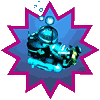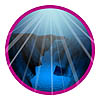|
Class Time Required |
3-5 class periods |
|
|
| About 1.5 hours to read through investigation, watch video, gather materials, and copy handouts. | |
|
Prior Student Knowledge |
Ability to work in small groups. Basic understanding of plate tectonics, photosynthesis, and pH will help students to understand the video. |
|
Vocabulary |
ballast, protocol, audio, sonar screen, HMI lights, archaeology, geophysicist, ROV, submersible, mid-ocean ridge, mercator projection, Rift Valley, telepresence, edifice, hydrothermal, methane, inextricably |
| Science GLEs Addressed |
6th Grade: SA1.1, SE1.1, SE3.1 7th Grade: SA1.1, SE3.1 8th Grade: SA1.1 |
 Overview: Students begin this 3-4 day investigation with a discussion and activity centered around seven traditional reasons that people explore. Then they go on an imaginary journey to the unknown. Once the journey is over, the students are given clues to discover that their trip was in a manned submersible in the Bering Sea. They learn about a researcher who is actually studying the Bering Sea in a submarine, then watch and discuss a video featuring underwater explorer Robert Ballard. As a final activity in this investigation, students research past and present ocean explorers and share their discoveries, inventions, or research.
Overview: Students begin this 3-4 day investigation with a discussion and activity centered around seven traditional reasons that people explore. Then they go on an imaginary journey to the unknown. Once the journey is over, the students are given clues to discover that their trip was in a manned submersible in the Bering Sea. They learn about a researcher who is actually studying the Bering Sea in a submarine, then watch and discuss a video featuring underwater explorer Robert Ballard. As a final activity in this investigation, students research past and present ocean explorers and share their discoveries, inventions, or research.


 Overview: In this 5-7 day investigation, students learn about vehicles used to explore the sea. They then learn about two deep sea canyons in the Bering Sea and the variety of life found in these canyons. Finally, students create a mural of one of the canyons, and participate in a sampling simulation to determine life in the canyon.
Overview: In this 5-7 day investigation, students learn about vehicles used to explore the sea. They then learn about two deep sea canyons in the Bering Sea and the variety of life found in these canyons. Finally, students create a mural of one of the canyons, and participate in a sampling simulation to determine life in the canyon. Overview:
Overview:  Overview: This 3-day investigation begins with students listening to a variety of underwater sounds, and deciding if the sound was made by an animal or something else. They learn about sound and how sound works in water, and about a researcher in the Bering Sea who is using sound to study the North Pacific right whale. Students learn about hydrophones and participate in an activity that simulates the use of hydrophones. Finally, they learn about spectrograms and try to identify animals by looking at the spectrograms and listening to the associated sounds.
Overview: This 3-day investigation begins with students listening to a variety of underwater sounds, and deciding if the sound was made by an animal or something else. They learn about sound and how sound works in water, and about a researcher in the Bering Sea who is using sound to study the North Pacific right whale. Students learn about hydrophones and participate in an activity that simulates the use of hydrophones. Finally, they learn about spectrograms and try to identify animals by looking at the spectrograms and listening to the associated sounds. Overview: In this 3-4 day investigation, students go outdoors to explore their local water body, using sampling techniques to discover the plants and animals.
Overview: In this 3-4 day investigation, students go outdoors to explore their local water body, using sampling techniques to discover the plants and animals. Overview: During this 7-8 day investigation, students create a list of ocean topics that they may have heard of or are familiar with, and then choose a topic to explore. They create a presentation to share their new knowledge with others.
Overview: During this 7-8 day investigation, students create a list of ocean topics that they may have heard of or are familiar with, and then choose a topic to explore. They create a presentation to share their new knowledge with others.






